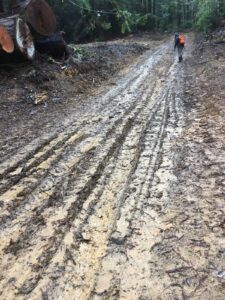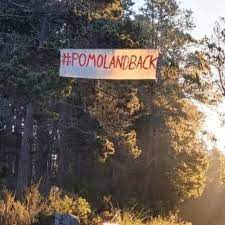
photo credit Earth First! Caption: silt runoff from logging road 359 in the Red Tail THP. Silty mud on the road measures 5 inches deep in places, the devastating result of heavy machinery work in wet weather. The fine particle mud can be seen flowing off the road down towards the Noyo River, where the silt will make the water inhospitable to salmonids and other fish species.
For immediate release
- Dec. 14, 2022
- Contact: Naomi Wagner (707) 502-6181, (707) 459-0548
- Andy Wellspring (707) 367-470
Citizen Monitors Document Damaged Roads, Felled Trees on Contested Logging Plan in Jackson Demonstration State Forest
Ft. Bragg, CA-Citizen monitors were out in Jackson State Demonstration Forest (JDSF) on Monday and Tuesday this week to check on a contested timber harvest plan (THP) known as Red Tail, which they say is a prime example of the mismanagement typical of CalFire’s antiquated Management Plan. CalFire, the managing agency for the 50,000-acre publicly-owned forest both writes and approves timber harvest plans that are then put out to bid by private timber companies. Activists are calling for a complete moratorium on all logging and road-building activities in Jackson until the old management plan is replaced to address urgent issues of climate change and cultural protections. Not only is the Management Plan inadequate, but CalFire also disregards its’ own rules, activists say.
The Red Tail monitors split into two groups each day, with one group holding protest signs at the entrance to the THP, just east of Fort Bragg off Highway 20, to alert the public to logging in the “People’s Forest.” Another group entered the THP area adjacent to the Camp One campground and the Egg Taking Station, to document alarming levels of runoff on rutted roads carrying sediment from recent rains towards the salmon spawning grounds below. Activists photographed sediment in the South Fork Noyo and reported it was “not looking too pristine” after only 2 inches of rain and 7″ season total. Many trees had been felled across a class 3 water course marked WLPZ [Watercourse and Lake Protection Zone]. Other photos showed large openings in the canopy, making a mockery of the “Old Forest Development Area” (OFDA).
“It is distressing to see that the rules governing OFDAs (Older Forest Development Areas) CAL FIRE’s Option A are being disregarded. In the 2016 Management Plan, two continuous corridors of unbroken canopy are called for, one stretching East to West, one North to South, across the entire forest. However, logging in the Red Tail THP, along with other THPs, has created hundreds of acres of breaks in the canopy, fragmenting wildlife habitat and increasing dryness of the forest floor,” said coastal resident and monitor, Chad Swimmer.
An “Older Forest Development Area” area is supposed to be managed by CalFire for characteristics such as large older trees and snags, connecting it to wildlife corridors. The 345-acre Red Tail THP did contain mostly second-growth redwoods and a few old growth trees before cutting reduced its numbers. Trees measuring up to five feet, or 60” in diameter have been cut.
“Taken all together, these kinds of operations – especially in the winter – create a huge disturbance in the forest. It’s a perfect picture of the usual industrial logging -just extraction – certainly not moving towards older forest development. Who would live there after the habitat is gone?” commented veteran THP monitor, Linda Perkins, referring to the plight of endangered species who need old forest habitat.”
Another citizen monitor, Andy Wellspring, said of the two days in Red Tail: “We are monitoring all THPs that CalFire has approved in this State forest. It is very saddening to see that the largest trees in Red Tail have been cut, even though they provide the most canopy, which both provides habitat for so many species and shades the forest floor and prevents fires. I urge the State to pursue equal co-management with the Coyote Valley Band of Pomo Indians immediately. These logging operations must end until equal co-management with Tribal people can restore this forest.”
Created in 1947 under a mandate “to produce high-quality timber products” alongside recreation and wildlife, timber sales provide the annual operating budget and pay the salaries of CalFire employees managing Jackson. This year, however, the State gave CalFire $10 million for “non-timber related” activities after declaring no new timber contracts would be offered. Activists would like to see CalFire buy out Willits Redwood Company’s contract on the Caspar 500, another highly contested Jackson plan.
Protests in Jackson have been non-stop since 2021, with twelve arrests for nonviolent civil disobedience, including six in Red Tail and six at the Natural Resource Building in Sacramento while protesting to protect the forest. No charges have been filed. The Coalition to Save Jackson Forest is waging a State-wide campaign to turn JDSF into a different kind of demonstration, one of equal co-management with the Coyote Valley Band of Pomo Indians, descendants of the original inhabitants of Jackson Forest, under a new Mandate based on respect, restoration and recreation and without commercial logging.
Photos:
Big trees down: photo credit Earth First! Caption: One of many log decks in the Red Tail THP in JDSF that show large trees cut in what is supposed to be the Older Forest Development Zone.
https://drive.google.com/file/d/1Xkj_prKQmz9wVssJlEomuEEGQXfgUV_t/view
muddy road: photo credit Earth First! Caption: silt runoff from logging road 359 in the Red Tail THP. Silty mud on the road measures 5 inches deep in places, the devastating result of heavy machinery work in wet weather. The fine particle mud can be seen flowing off the road down towards the Noyo River, where the silt will make the water inhospitable to salmonids and other fish species.
https://drive.google.com/file/d/110H0H-cdrtdlYfjP5bnb9lxDyAwxvL1r/view?usp=sharing
Red Tail THP graphic:
https://drive.google.com/file/d/1rggIyZd0iLQ85nYZ91H6s51hnZlaO8vu/view
###



